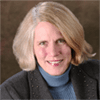2015 Winner: Outstanding Contribution To The Alberta Science And Technology Community
Calgary water expert dedicates career to water management
Water is easily the most important resource we interact with every day. It is vital to our survival and it is also unique because every industry uses it in some capacity.
As CEO of Alberta WaterSMART in Calgary, Kim Sturgess makes it her business to know how to effectively manage water across a wide range of scenarios.
“We’ve come to realize water is something everybody is attached to,” Sturgess says. “In every industry we’ve worked with, we’ve found everyone needs some advice on water use.”
Alberta WaterSMART collaborates with businesses, government and communities to help them manage water. Sturgess and her team of experts tackle a range of water-related challenges, spanning challenges including strategic assessment and facilitation for infrastructure, policy response and awareness, and technical solutions to improve water efficiency and reuse.

“Sometimes we have clients who work in the oil industry, so water is often a waste product to them,” Sturgess says. “In other areas we have people who need access to more clean water to help grow their business. Through smart water management we help both of these groups overcome their obstacles.”
Leading out of a crisis
Recently, Sturgess and her team worked on a project very close to home. As residents of Calgary and experts in water management, Alberta WaterSMART was deeply impacted by the 2013 Alberta flood.
“Immediately following the flood our team began work on a white paper report, highlighting the areas we knew needed improvement, so we could be better prepared for another similar event in the future,” Sturgess explains.
When Sturgess and her team started on the report, they were primarily motivated to identify ways to protect the community and the watershed in the future. Sturgess says in the end her team focused on several points of improvement, from anticipating and planning for more extreme weather events to considering flood risks in municipal planning.
“We highlighted six areas that needed immediate improvement in the areas surrounding the Bow River,” Sturgess says. “The report was first filed on August 2nd 2013 and soon after we were contracted to consult for the Alberta government’s Flood Recovery Team. We actually started working on the report the day after the flood.”
The white paper, titled The 2013 Great Alberta Flood: Actions to Mitigate, Manage and Control Future Floods, resulted in new policies and the creation of improved flood infrastructure, including the inception of initiatives such as Room for the River – a project that utilizes natural flood mitigation and land use options to reduce the impacts of both flooding and drought.
Bringing people together
Sturgess says often when she works on a project it is not easy to create alignment on the end goal. Often her team works with multiple external groups who have conflicting ideas, motivated by politics, business policies, or personal interests.
“One of the things we try to do is eliminate the politics surrounding water usage,” Sturgess says. “If we provide the right facts to individuals, it’s difficult to argue with what we’re trying to accomplish. When people can understand the procedure and it helps them think more about the work they’re doing and how it relates to water, we find solutions everybody will find acceptable.”
Sturgess says it all goes back to the universal application of water and the common foundation water creates in a community – it is no secret future prosperity is linked to how well we all manage our water.
“I think I speak for a lot of Albertans when I say this province is a stunningly beautiful place to live and, if we work effectively together, with real respect for water and its value in society, I see many more generations able to live a fortunate life here.”
